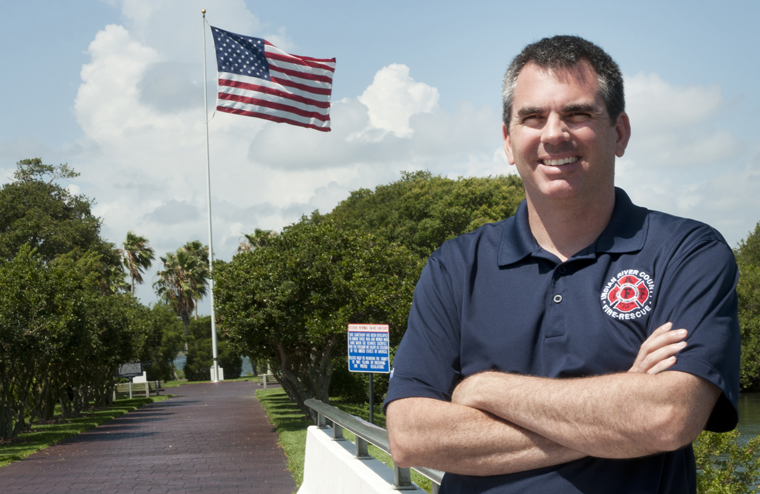
There’s a new president at the helm of the Indian River County Firefighters’ Association, which represents more than 220 Indian River County Fire Rescue firefighters and paramedics. John O’Connor, a driver/engineer paramedic currently stationed at Firehouse No. 8 in Sebastian, was recently elected to the post, replacing past President Bruce Anderson.
As a labor organization, the association represents a membership which provides countywide 24/7 emergency response to all but Indian River Shores, the county’s only municipality with its own force. Fire Rescue provides them with assistance as needed.
Although born in Boston, O’Connor was raised in Vero Beach, graduating from Vero Beach High School before receiving an Associate’s degree from Indian River State College and a Bachelor’s in Psychology from the University of Central Florida. He married wife Brenda six years ago.
“A retired Cincinnati firefighter suggested firefighting as a career path,” says O’Connor. “I called around and did a little survey and there was not one negative thing that came back.”
He zipped through Emergency Medical Training in six weeks, Fire School in 12 weeks, and was hired inside of three months. He partially attributes the quick hire to good timing as the new Orchid Island station was just opening. That was in May 2000 and he has since worked out of each of the 12 stations scattered throughout the county.
Only one station has been added since then, but O’Connor is optimistic that the force will continue to grow.
“Typically, calls for service go up at about 2 or 3 percent per year,” he explains. “If you have the same amount of firefighters and trucks, it becomes more difficult to provide the same amount of service. The taxpayers expect a level of service, and it’s our duty to try to do the best we can with what we have.”
While the more obvious aspect of their job is combating fires, he adds, “We have so many facets that we are responsible for. My job is to educate the public about all of our jobs.”
Firefighting and Emergency Medical Services were consolidated at the end of 2005, with most stations housing an engine and an ambulance, which is why fire trucks often arrive in response to 911 medical emergencies.
“I can ride in an ambulance or a fire truck. You’re getting the same person, just a different piece of apparatus,” O’Connor explains.
“If the ambulance is on a call, which they typically are, we have nine ALS (advanced life support) engines. The engine has all the tools that the ambulance has with the exception of the stretcher. We can go provide ALS to that patient until the ambulance arrives to transport them. We get them all ready; administer IVs, take vitals, write up a report; whatever is needed. When the ambulance arrives, we put them in and they’re set to go. If it’s a serious call, if the patient is not breathing or is unconscious, we both go.”
In addition to firefighting and EMS, Dive Rescue is utilized for body and weapons recovery and to ensure safety during mini-lobster season when hundreds of divers take to the water to capture tasty crustaceans.
The Marine Station has a boat with a fire pump to combat boat fires, and High Angle Rescues assist individuals stuck in high spaces, such as when trimming a tree or working on a roof.
An Airport Firefighting Crash Truck is continually at the ready, and a Hazardous Material Response team deals with dangerous chemicals.
There are also certified inspectors to ensure the safety of commercial buildings and schools, and arson detection investigators.
“Fire prevention is a big part of our job,” says O’Connor, adding that his goal is to inform the public about fire safety through a “hot topic of the month.”
For example, he says many people know to change their smoke detector batteries when resetting clocks for Daylight Savings Time. What they don’t know is that they should cover 9-volt battery terminals with tape before throwing them in the trash, because uncovered terminals that touch together can ignite a fire.
“They’re doing the right thing, but they can actually burn their house down if they don’t cover the terminals.”
A message during hurricane season might be about the dangers of carbon monoxide poisoning from generators kept in the home or garage.
Another topic might be about yielding (ideally to the right) to emergency vehicles, rather than hitting the brakes. Additionally, people are often so engrossed with their phones, that they remain completely unaware of their surroundings.
“We see them all the time. We’ve got a 150-decibel siren on the truck and they can’t see or hear; that’s a major hazard for us trying to get to a call as safely as possible.”
The Firefighters’ Association has also formed separate benevolent groups for the benefit of the community.
In light of the upcoming May 26 Memorial Day ceremonies, which will also recognize the 50th anniversary of Memorial Island, the firefighters have developed a 30-second PSA, with nostalgic footage from past wars that will air all through the Memorial Day weekend.
In March, the Firefighters’ Association finished one of the most successful Firefighters’ Fairs in its 34-year history, with moneys raised going toward the Indian River County Burn Fund, scholarships and fairground improvements.
A separate Indian River County Firefighters’ Benevolent fund was formed more recently to take advantage of Firefighter license tag money. It also enables them to provide tax-deductible donations to supporters of fundraisers such as the Chili Cookoff and Tour de Vero, which benefit local nonprofit organizations including Childcare Resources, Youth Guidance, the Vero Beach High School band and football team, the Indian River Soccer Association and numerous others.
“All the associations were formed to benefit the community,” says O’Connor. “It’s a way to give back to the residents of Indian River County and to support our own, especially youth programs to help the parents out.”



